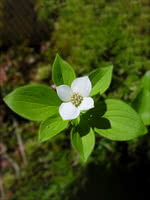Mon-Fri 9am - 5pm Mountain time
Bunchberry vs Nodding Onion
Allium cernuum
Cornus canadensis
NOT AVAILABLE THIS SEASON - MIGHT RETURN
NOT AVAILABLE THIS SEASON - MIGHT RETURN
Nodding Onion is a native perennial wildflower known for its nodding clusters of flowers that range in color from white to pink to purple. The lightly scented blooms provide pollen and nectar for pollinators, especially bees, which can collect while hanging upside down, a capability most other insects lack.
The narrow, grass-like leaves of the Nodding Onion can be used as a seasoning in cooked dishes, though bulbs and raw leaves should not be eaten in large quantities. All parts of the plant have an onion-like aroma when bruised, which helps deter deer and rabbits. They can self-seed readily, so removing spent blooms helps manage their spread. Tolerant of a range of soils, including alkaline, it is well-suited for a variety of plantings, including pollinator gardens and naturalization projects.
The Bunchberry, or Quatre-Temps as it is commonly known in Quebec, is an excellent ornamental plant to have in your garden. With star-shaped white flowers in spring and clusters of bright red berries in the fall, this is one of the most refined and hardy groundcovers available. The foliage has ornamental value, with leaves going from a deep green in the spring and summer to a beautiful brick-red in the fall.
Bunchberry is a spreading evergreen perennial with a ground-hugging habit of growth. This plant is not well suited for urban areas close to streetsides, as it is quite intolerant to pollution. It is Canada’s national flower.
According to a poll done by the Master Gardeners of Ontario, it is one of the most recognizable Canadian flowers.
Its flowers grow with elastic petals and "fire" its pollen with the force of 2000-3000 times the force of gravity.
Nodding Onion Quick Facts
Bunchberry Quick Facts
Toxicity: raw leaves and bulbs can be midly toxic

